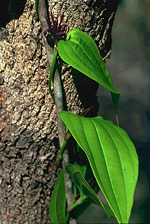 |
This small family is restricted to south-east Asia from India and southern China to New Guinea and northern Australia, in woodlands, monsoon forests and rainforest margins.
Characteristic features of the family Stemonaceae in Australia include: - herbs with twining or prostrate stems to several metres long with alternate, narrowly to broadly ovate leaves with parallel veins and prominent, finer cross-veins
- flowers bisexual, regular, with 4 petal-like perianth segments and 4 stamens with rather broad, petaloid filaments, the connective extending well above the anther
- ovary superior, 1-carpellate, developing into a 2-valved capsule
Description
Herbaceous vines climbing by twining or scrambling stems, or perennial
terrestrial herbs. Perennating by rhizomes. Internal secretions not obvious.
Plants glabrous. Leaves alternate and spiral, or distichous, or opposite,
cauline, petiolate. Stipule-like lobes absent. Lamina simple, symmetric,
filiform, acicular, subulate, linear, lanceolate, ovate, elliptic or oblong;
base cuneate, cordate or hastate or sagittate; margins entire, ±flat;
venation parallel, with the midrib conspicuous, and the tertiary venation
reticulate; surfaces not punctate; herbaceous. Leaf ligule absent. All
the flowers bisexual. Inflorescences axillary, consisting of dichasial
cymes or solitary flowers. Bracts present. Pollination by insects. Flowers
odourless or malodorous, stalked. Floral disc present or absent; nectaries
absent. Perianth regular, of 2 ±similar whorls, with 4 free or
fused, ±petaloid segments, valvate in bud, cream, red, purple,
grey, brown or black, without contrasting markings, membranous or herbaceous;
claws absent; lobes ±entire. Fertile stamens 4, alternating with
or opposite to and at least partly fused to the perianth segments, free
of the ovary and style, distinct from each other, or fused by their filaments
into an open or closed tube, all ±equal. Anthers basifixed, not
versatile, opening sideways by longitudinal slits, 2-celled; appendages
apical. Ovary superior and sessile. Carpel 1; ovary with 1 locule. Style
terminal, single and unbranched, or absent and the stigma ±sessile.
Ovules 2–8, stalked; placentation basal. Fruit a dry, dehiscent, bi-valved
capsule; the perianth on the maturing fruit deciduous. Disseminule micro-surface
finely striate-costellate, dull. Seeds 1–8 per fruit. Aril present. Cotyledons
1.
(Note: this description has been generated from the coded data compiled
for the key. Any errors in the key data will be reflected in the descriptions.)
A treatment of the family Stemonaceae has been published in:
Flora of Australia 46: 177-180.
Australian genera of Stemonaceae (as recognised for the Flora of Australia)
Stemona

|
  |

Stemona australiana (flower)
Photo: D.Jones © D.Jones

Stemona lucida (= S. philippinensis) (flower)
Photo: M.Fagg © ANBG
|
 |
|